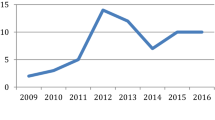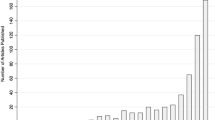Abstract
The main purpose of this paper is to document the challenges within spatial risk and vulnerability assessments in order to instigate an open discussion about opportunities for improvements in approaches to disaster risk. This descriptive paper identifies challenges to quality and acceptance and is based on a case study of a social vulnerability index of river floods in Germany. The findings suggest the existence of a vast range of challenges, most of which are typical for many spatial vulnerability assessments. Some of these challenges are obvious while others, such as the stigmatisation of ‘the vulnerable’ in vulnerability maps, are probably less often the subject of debate in the context of quantitative assessments. The discussion of challenges regarding data, methodology, concept and evaluation of vulnerability assessment may help similar interdisciplinary projects in identifying potential gaps and possibilities for improvement. Moreover, the acceptance of the outcomes of spatial risk assessments by the public will benefit from their critical and open-minded documentation.

Similar content being viewed by others
References
Adger WN (2006) Vulnerability. Glob Environ Change 16:268–281
Anderson MB, Woodrow PJ (1998) Rising from the ashes: development strategies in times of disaster. Lynne Rienner, Boulder
Backhaus K, Erichson B, Plinke W, Weiber R (2006) Multivariate analysemethoden, 11th edn. Springer, Berlin
Benson C, Twigg J (2004) ‘Measuring mitigation’ methodologies for assessing natural hazard risks and the net benefits of mitigation—a scoping study. ProVention Consortium, Geneva
Bernard HR (2006) Research methods in anthropology. Qualitative and quantitative approaches, 4th edn. Altamira Press, Oxford
Birkmann J (ed) (2006) Measuring vulnerability to natural hazards: towards disaster resilient societies. United Nations University Press, Tokyo
Cao C, Lam NSN (1997) Understanding the scale and resolution effects in remote sensing and GIS. In: Quattrochi DA, Goodchild MF (eds) Scale in remote sensing and GIS. Lewis Publishers, Boca Raton, pp 57–72
Cutter SL, Boruff BJ, Shirley WL (2003) Social vulnerability to environmental hazards. Soc Sci Q 84(2):242–261
Damm M (2010) Mapping social-ecological vulnerability to flooding. A sub-national approach for Germany. Graduate Series (3). United Nations University—Institute for Environment and Human Security (UNU-EHS), Bonn
Egner H, Pott A (eds) (2010) Geographische Risikoforschung. Zur Konstruktion verräumlichter Risiken und Sicherheiten. Erdkundliches Wissen 147. Working group book. Stuttgart, Steiner Verlag
Fekete A (2009a) Report on “Disaster preparedness in South Caucasus”, Armenia. PN 07.2050.8-001.00 GTZ, Mar 2009, unpublished. Gesellschaft für Technische Zusammenarbeit (GTZ), Eschborn
Fekete A (2009b) The Interrelation of social vulnerability and demographic change in Germany. In: IHDP open meeting 2009, the 7th international science conference on the human dimensions of global environmental change, Bonn
Fekete A (2009c) Validation of a social vulnerability index in context to river-floods in Germany. Nat Hazards Earth Syst Sci 9:393–403
Fekete A (2010) Assessment of social vulnerability to river-floods in Germany. Graduate Series (4). United Nations University—Institute for Environment and Human Security (UNU-EHS), Bonn
Fekete A, Damm M, Birkmann J (2010) Scales as a challenge for vulnerability assessment. Nat Hazards 55(3):729–747. doi:10.1007/s11069-009-9445-5:729–747
Fromm S (2005) Binäre logistische Regressionsanalyse. Eine Einführung für Sozialwissenschaftler mit SPSS für Windows, Bamberger Beiträge zur empirischen Sozialforschung, Schulze, G.; Akremi, L., Bamberg
Gall M (2007) Indices of social vulnerability to natural hazards: a comparative evaluation. PhD dissertation, University of South Carolina
Gibson C, Ostrom E, Ahn TK (1998) Scaling issues in the social sciences. International Human Dimensions Program (IHDP). IHDP Working Paper No 1. Bonn
Handmer J (2003) We are all vulnerable. Aust J Emerg Manage 18(3):55–60
Hewitt K (1983) Interpretations of calamity: from the viewpoint of human ecology (The risks & hazards series, 1). Allen & Unwin Inc., Winchester
(IKSR) Internationale Kommision zum Schutz des Rheins (2001) Rheinatlas. International Commission for the Protection of the Rhine, Koblenz
International Council for Science (2008) A science plan for integrated research on disaster risk: addressing the challenge of natural and human-induced environmental hazards. Paris
International Organization for Standardization (2009) ISO/IEC 31010:2009. Risk management—risk assessment techniques. Geneva
(IRGC) International Risk Governance Council (2008) An introduction to the IRGC risk governance framework. International Risk Governance Council, Geneva
King D (2001) Uses and limitations of socioeconomic indicators of community vulnerability to natural hazards: data and disasters in Northern Australia. Nat Hazards 24:147–156
Kuhlicke C, Scolobig A, Tapsell S, Steinführer A, De Marchi B (2011) Contextualizing social vulnerability: findings from case studies across Europe. Nat Hazards. doi:10.1007/s11069-011-9751-6. Published online 02 Mar 2011
Lüchters G, Menkhoff L (1996) Human development as statistical artefact. World Dev 24(8):1385–1392
Meentemeyer V (1989) Geographical perspectives of space, time, and scale. Landsc Ecol 3(3/4):163–173
Meyer V, Haase D, Scheuer S (2007) GIS-based multicriteria analysis as decision support in flood risk management. Umwelt Forschungs Zentrum (UFZ) Discussion Papers 6/2007. Leipzig
Moore DS, MacCabe GP (2006) Introduction to the practice of statistics. Freeman, New York
Nardo M, Saisana M Saltelli A, Tarantola S, Hoffman A, Giovannini E (2005) Handbook on constructing composite indicators: methodology and user guide. OECD Statistics Working Paper. JT00188147, STD/DOC(2005)3
O’Brien K, Leichenko R, Kelkar U, Venema H, Aandahl G, Tompkins H et al (2004) Mapping vulnerability to multiple stressors: climate change and globalization in India. Glob Environ Change 14:303–313
Openshaw S (1984) The modifiable areal unit problem. Geo Books, Norwich
Richardson K (2005) The hegemony of the physical sciences: an exploration in complexity thinking. Futures 37:615–653
Robinson WS (1950) Ecological correlations and the behavior of individuals. Am Sociol Rev 15(3):351–357
Schauser I, Otto S, Schneiderbauer S, Harvey A et al. (2010) Urban regions: vulnerabilities, vulnerability assessments by indicators and adaptation options for climate change impacts—scoping study. The European Topic Centre on Air and Climate Change (ETC./ACC). ETC./ACC Technical Paper 2010/12. Dec 2010. AH Bilthoven
Schmidt-Thomé P (Ed) (2006) Final report. The spatial effects and management of natural and technological hazards in Europe—ESPON 1.3.1. ESPON—European Spatial Planning Observation Network
Schneiderbauer S (2007) Risk and vulnerability to natural disasters—from broad view to focused perspective. Doctoral thesis. FU Berlin
Simpson DM, Katirai M (2006) Indicator issues and proposed framework for a disaster preparedness index (DPi), Working Paper 06-03, Center for Hazards Research and Policy Development, University of Louisville
Steinführer A, Kuhlicke C (2007) Social vulnerability and the 2002 flood. Country Report Germany (Mulde River). Floodsite Report Number T11–07-08. UFZ Centre for Environmental Research, Leipzig
Tapsell SM, Penning-Rowsell EC, Tunstall SM, Wilson TL (2002) Vulnerability to flooding: health and social dimensions. Philos Trans R Soc A 360:1511–1525
Tapsell S, McCarthy S, Faulkner H, Alexander M (2010) Social vulnerability to natural hazards. CapHaz-Net WP4 Report, Flood Hazard Research Centre—FHRC, Middlesex University, London
Tierney K, Bruneau M (2007) Conceptualizing and measuring resilience: a key to disaster loss reduction. Transportation Research Board of the National Academies, May–June, 2007, pp 14–17
Turner BL, Kasperson RE, Matson PA, McCarthy JJ, Corell RW, Christensen L et al (2003) A framework for vulnerability analysis in sustainability science. Proc Natl Acad Sci USA 100(14):1–6
(UNISDR) United Nations International Strategy for Disaster Reduction Secretariat (2007) Hyogo framework for action 2005–2015: building the resilience of nations and communities to disasters. United Nations International Strategy for Disaster Reduction Secretariat, Geneva
(UNU-EHS/ADRC) United Nations University—Institute for Environment and Human Security, Asian Disaster Reduction Center (2005) Expert workshop. Measuring vulnerability. UNU-EHS, Kobe, Japan. In: Birkmann J (ed) Working Paper No. 1. UNU-EHS, Bonn
Wisner B, Blaikie P, Cannon T, Davis I (2004) At risk—natural hazards, people’s vulnerability and disasters, 2nd edn. Routledge, London
Acknowledgments
The author is especially grateful for the inspirations and critique of Christian Kuhlicke and Annett Steinführer, and the input of ideas and feedback provided by Stefan Kienberger and Niklas Gebert regarding this specific paper. The author is also indebted to the constructive feedback received from anonymous reviewers. This paper summarises experiences and work spanning more than 10 years, and there are numerous other people and institutions to thank for their support, encouragement, funding and ideas.
Author information
Authors and Affiliations
Corresponding author
Rights and permissions
About this article
Cite this article
Fekete, A. Spatial disaster vulnerability and risk assessments: challenges in their quality and acceptance. Nat Hazards 61, 1161–1178 (2012). https://doi.org/10.1007/s11069-011-9973-7
Received:
Accepted:
Published:
Issue Date:
DOI: https://doi.org/10.1007/s11069-011-9973-7




